We are committed to producing safe, dependable, high-quality natural & organic agronomic inputs.
Pond Clean
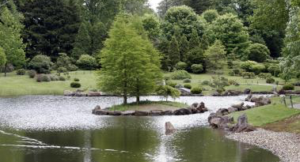
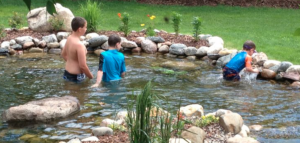
POND CLEAN is the perfect fully sustainable, non-toxic, probiotic cleaning solution for ponds, irrigation dams, rivers, lakes, fish farms and wetland areas. The liquid concentrate contains powerful microbes that break down organic waste in ponds, dams, lakes, rivers and canals without the consumption of oxygen and the production of foul odours. POND CLEAN eliminates foul odours and conditions the water by reducing nitrates and phosphates, which are essential food for algae. It is non-toxic, non-corrosive and safe to use around humans, animals and plants.
INCREASES BIOLOGICAL ACTIVITY
Applying POND CLEAN restores the beneficial bacteria population in the pond and increases the biological activity. The bacteria in POND CLEAN “sense” the type of wastes around them. The bacteria produce metabolites including enzymes which can automatically attack the different types of waste. Unlike bacteria, enzymes do not reproduce because they aren’t alive. Bacteria are living organisms, while enzymes are organic compounds.
The beneficial bacteria in POND CLEAN act like a natural garbage disposal for your pond. As the colonies of bacteria grow they feed on the very same nutrients that algae like to feed on. The bacteria will begin to consume decaying plant matter and fish waste and will continue to eat and multiply for 12-16 weeks. The regular use of a pond bacteria will ensure that continual new colonies of bacteria will emerge and scrub the pond clean of the nutrients that algae require to grow. If algae does not have a food supply then it cannot thrive.
The reason for the proliferation of algae is largely due to the presence of above average concentrations of Nitrates (N) and Phosphates (P) in the water. Catalysed by warmth and long sunshine hours (ideal for rapid photosynthesis), the algae spores ‘bloom’ and multiply, often at incredible speed, depleting the water of oxygen as they do so. Eventually they form a floating blanket that prevents the uptake of oxygen by the reduced water surface area.
POND CLEAN populates the polluted water with beneficial microorganisms so that they dominate and out-compete the toxoc, disease causing organisms ensuring the biodegardation of Nitrates and Phosphates is effectively controlled. A revolutionary proprietary EM (effective microorganisms) product for aquaculture and waterway treatment which creates a healthier environment, reduces diseases, reduces algae and unpleasant odours, adds sparkle to water and visually cleans ponds, lakes, reservoirs, lakes, irrigation storage dams, fish farms, and wetland areas.
Pond Clean is the perfect fully sustainable, non-toxic cleaning solution for ponds, reservoirs, lakes, rivers, irrigation storage dams, and wetland areas.
USES
Fish Ponds, Dams, Canals, Irrigation storage systems, Aquaculture, Farm ponds, Golf course ponds, wetland areas etc
BENEFITS:
* Removes algae
* Reduces nitrates and phosphates
* Eliminates odours
* Reduces BOD/COD concentration
* Creates a safe, healthy environment
* Reduces solids and organic wastes
* Cleans, clears & conditions water naturally
* Promotes healthy environment for fish
* Contains no chemicals
* Non-Toxic
* Cost effective and easy to use.
* Made in New Zealand
BEFORE TREATMENT:
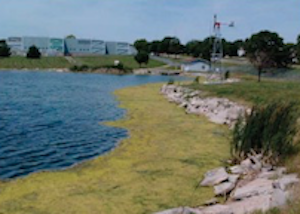
AFTER TREATMENT:
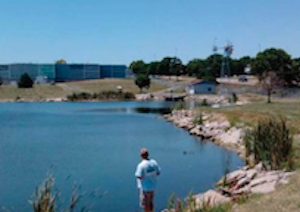
Application rates are dependent on a number of factors and we will advise you of
the most suitable size for your needs. For more severe or complex situations we
can design specialist microorganism cultures according to the problem.
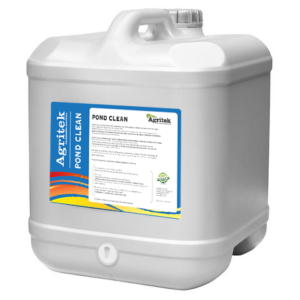
Packaging options
Pond Clean is available in 1, 20, 200 and 1,000 litre containers.
DIRECTIONS:
Apply at the inlet source or directly to the affected area.
Sufficient aeration and reticulation is essential, especially at higher dosages.
The dosage can be safely increased up to five times for extreme potency based on water conditions.
Initial Application: 2-4 litres of Pond Clean per 100m3 of water (100,000 litres)
Second Application: 3 to 4 weeks after initial dose add another 2-4 litres per 100m3 water Maintenance: 1-2 litres per 100m3 (2 to 3 times per year)
HOW DOES POND CLEAN WORK ?
ALGAE PROBLEMS
Algae problems occur whenever you have a combination of pond water, sun, N(nitrogen) and P (phosphorous). Sun and N are the biggest problems, while P contributes to a lesser degree in most ponds (and is sometimes the dominant cause of algae blooms).
The live bacteria in POND CLEAN compete with the algae for N and P food. The bacteria consume N and P faster than the algae. As a result, excess algae is eliminated. It is very important to note that not all algae is eliminated. Some algae are needed to help keep oxygen in the water.
POND CLEAN only eliminates the severe bloom. The best way to think about it is that POND CLEAN restores the natural balance in a pond, which means a healthy mix of natural bacteria and algae living together. Through use of POND CLEAN, a pond is restored to its’ natural clarity and beauty.
SLUDGE & ODOUR PROBLEMS
Almost all ponds, particularly older ponds, have sludge build up. Sludge is the organic sediment located at the bottom of the pond. Several problems happen when the sludge build up gets heavy. The pond may have plenty of oxygen in the water near the top of the column, but in the sludge at the bottom of the pond, there is very little oxygen. Disease-causing, odour- causing “anaerobic bacteria” live in the sludge at the bottom of the pond. The worse the sludge build up, the greater the risk of fish disease, and the worse the odours are. Foul pond odours (usually thought of as “rotten egg smell”) come from the sludge in the bottom of the pond. POND CLEAN digests the sludge at the bottom of a pond. This means that the risk of fish disease is reduced, and foul pond odours are eliminated.
NOTE:
POND CLEAN digests organic sludge (leaves, dead algae, fish waste, etc.). It does not digest clay, sand or silt.
UNDERSTANDING POND WATER TECHNOLOGY
BENEFICIAL BACTERIA
Beneficial pond bacteria like that in POND CLEAN are naturally occurring bacteria that break down organic waste in ponds and convert toxic ammonia to nitrite and eventually nitrate. Beneficial pond bacteria are aerobic, meaning they require oxygen, which is another reason proper aeration is very important.
WATER PH
Water PH balance is measured on a scale from 1-14 that is based on the concentration of hydrogen ions in the water. A pH of 7 is considered neutral and is the optimal level for a pond and its processes to function optimally. A pH level that is above 7 is considered alkaline and anything below 7 is acidic. The term buffering is used with regards to pH whenever something is introduced into the water that moves the pH from an alkaline level toward the acidic level or vice versa. This can be achieved intentionally through commercial water conditioners or unintentionally through a variety of factors.
These factors include decaying organic matter like grass clippings, dead plants and excess fish food, fish and animal waste and even fertilizer, release nitrogen into the water normally in the form of ammonia, nitrite and nitrate, which can be toxic to fish if the levels get too high. In a biologically balanced pond, the ammonia is turned into nitrite and then eventually nitrate, which is far less toxic and can be used by plants or depleted with a water change.
This decomposing waste, fertilizer and excess fish food also produces a nutrient called phosphate. While phosphate is considered a nutrient and is beneficial to soil, it is not a nutrient that is very beneficial to ponds. In fact, phosphate is the primary culprit behind algae growth. The excess phosphate and nitrogen can quickly cause an algal bloom, which can severely compromise the appearance and the health of a pond.
The primary way that nature combats nitrogen and phosphate is through dissolved oxygen. Dissolved oxygen is the most important factor for a healthy and clean pond. All of the material that falls into a pond that needs to decompose requires oxygen to do so.
DISSOLVED OXYGEN
Dissolved oxygen is also critical for the health of fish, as they require oxygen to process their food. Whenever there is an instance where there are too many fish in a pond or too much decomposing waste, oxygen levels can dramatically drop causing the rise in nitrogen and phosphate leading to fish kills and aggressive algal blooms. It is in these scenarios where oxygenation through aeration is critical.
AERATORS
Aeration is key for any pond environment, particularly smaller ponds with lots of fish. As mentioned earlier, fish food and fish waste can lead to increased nitrogen levels, but this is significantly reduced where aeration is provided and dissolved oxygen is introduced to help decay the waste. There are all types of methods of aeration such as fountains, waterfalls, diffused aeration, windmills and paddlewheels.
Fountains and waterfalls are very popular pond products because of the visual appeal they bring. However, their effects can be limited based on pond depth. Typically, fountains and waterfalls are best suited for shallow ponds as they generally only oxygenate the top portion of the water column. Because it is crucial that the fountain or waterfall create lots of turbulence at the surface so that the maximum amount of oxygen can be dissolved, fountains that produce a finer mist of water droplets create more turbulence than big droplets and are a better option.
Diffused aerators are the best option for aerating deep ponds. They use compressors to force air, through tubing, to the bottom of the pond, where it is pushed out and upward. They are also excellent choices for pond owners who prefer less surface movement than what you get from fountains and paddlewheels.
Paddlewheels offer similar advantages and disadvantages as the fountains. They typically are best in shallow water environments and not as efficient in deeper water. They are more efficient than fountains and waterfalls at dissolving oxygen due to the agitation effect from the rotating blades.
Solar powered systems are available that operate strictly during day- light hours or during both daylight and night hours.
WHY REPEAT DOSES ARE NECESSARY
Warm weather affects dissolved oxygen levels, encourages algae growth and makes fish more active leading to increased feeding and waste production. Warm water does not retain oxygen as well so you need to constantly pump oxygen back into the water. As noted earlier, increased dissolved oxygen levels will help the pond bacteria thrive and improve the reduction of ammonia, nitrites and nitrate, which fuel algae growth and also help fish digest and convert food to energy.
Summer months are when algae become commonplace and increasingly harder to control.
All types of debris and fertilizer, fish waste and even bird excrement may find their way into the water, plus fish are more active, leading them to feed more often, causing an influx of nutrients.
Additionally, more sunlight is penetrating the water fuelling photosynthesis within the algae.
When waste levels get too high, like in fish ponds or farm ponds that get lots of debris, fertilizer run-off or livestock waste, it can be hard for aerobic bacteria to keep up and anaerobic bacteria begin to takeover.
Once the oxygen levels drop and the anaerobic bacteria become prevalent, waste is more slowly broken down leading to noxious odours and increasingly harmful levels of ammonia and eventually the fish will die.
TIME LINE
POND CLEAN effectiveness is more gradual than typical chemical treatments.
It will take a month, and possibly 2 to 4 months in severe situations, to really solve severe problems. POND CLEAN is completely non-toxic and beneficial for water quality, fish, wildlife and aquatic plants.
ODOUR CONTROL
Odour problems should dissipate within two to three weeks of the first application. Rotten egg and septic odours will be eliminated, and only a natural, earthy smell will be present. Any visitors to the pond will appreciate this benefit!
ALGAE CONTROL
Within 1 or 2 applications, algae around the edges of the pond will begin to darken or turn brown.
That shows that the algae is dying, and is a sure sign of progress. Dead algae will eventually drop to the bottom of the pond. Between one to two months of treatment, it should be obvious that the algae bloom is being reduced and that the pond water is clearing. At this critical point, if progress is not yet satisfactory, continued the elevated dose for another month or two. By application 4, the pond should certainly be clear unless there is an unusual or unexpected aquatic condition.
NOTES:
POND CLEAN restores a natural balance between algae and bacteria. It eliminates the “excess” algae, it does not eliminate “all” algae.
Properly balanced ponds have a natural mixture of algae, bacteria, fish and desirable aquatic plants. Aquatic plants consume N and P nutrients. POND CLEAN does not starve these plants or rob them of nutrients.
DIRECTIONS:
Apply at the inlet source or directly to the affected area.
Sufficient aeration and reticulation is essential, especially at higher dosages.
The dosage can be safely increased up to five times for extreme potency based on water conditions.
Initial Application: 2-4 litres of Pond Clean per 100m3 of water (100,000 litres)
Second Application: 3 to 4 weeks after initial dose add another 2-4 litres per 100m3 water Maintenance: 1-2 litres per 100m3 (2 to 3 times per year)
